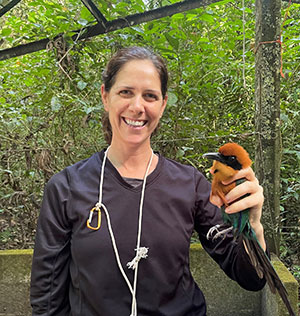
Contact Us
Institutional Communications
Bureau of Mines Building, Room 137
Laramie, WY 82071
Phone: (307) 766-2929
Email: cbaldwin@uwyo.edu
UW Researcher Part of Study That Reveals Severe Declines of Understory Birds in Panama Neotropical Forest
Published April 04, 2022

Corey Tarwater, an assistant professor in the UW Department of Zoology and Physiology,
poses with a Rufous motmot at the long-term net lines located on Pipeline Road in
Panama, where researchers have been capturing and banding birds for over 40 years.
Tarwater is co-author of a paper that was published in the Proceedings of the National
Academy of Sciences April 4. The paper examined the severe decline of understory birds
in a protected neotropical forest in Panama. (Anna Chalfoun Photo)
Researchers, including one from the University of Wyoming, report a large decline in bird abundance in a tropical forest in Panama, despite its status as a protected area. The finding potentially points to concerns about how tropical bird populations are faring.
Corey Tarwater, an assistant professor in the UW Department of Zoology and Physiology, says the researchers’ findings provide novel evidence that tropical bird populations may be undergoing systematic declines even in relatively intact tropical forests.
“Even in large, protected tropical forests, the abundance of 70 percent of understory bird species has declined over the last 44 years,” Tarwater says. “These large tracts of forest should be bastions of biodiversity, where populations of animals are healthy. Instead, we found declines in abundance across species, and these declines were severe for many species. Most of the declining species have lost over half of their initial estimated abundance.”
Tarwater is co-author of a paper titled “Long-Term Monitoring Reveals Widespread and Severe Declines of Understory Birds in a Protected Neotropical Forest” that was published in the Proceedings of the National Academy of Sciences (PNAS) today (April 4). PNAS is one of the world’s most cited and comprehensive multidisciplinary scientific journals, publishing more than 3,500 research papers annually.
Henry Pollock, a postdoctoral research associate in the Department of Natural Resources and Environmental Sciences at the University of Illinois at Urbana-Champaign, was the paper’s lead and corresponding author. Other contributors to the paper were from the University of Alberta in Edmonton, Alberta, Canada; the Canadian Wildlife Service; and the University of Washington.
The implications of the study’s findings are that biodiversity baselines may be shifting over time and large tracts of tropical forest may not be sufficient for maintaining stable bird populations.
“The bigger picture is that large tracts of forest may not be sufficient to protect biodiversity now and into the future,” Tarwater says. “We know that more than two-thirds of the world’s terrestrial species reside in tropical forests. So, it is globally important to understand where these declines are happening and why.”
During the study, researchers tracked the presence of bird species in a 22,000-hectare forest in Panama from 1977-2020. Twice each year, the researchers deployed mist nets in multiple study sites, where the species were captured and identified before being released.
Based on identification and counts, the research group modeled populations and estimated changes in abundance of 57 species over the 44-year period. The majority of sampled species declined in abundance, with 35 of the 40 declining species losing more than 50 percent of their initial abundance. The declines extended across different families and were generally independent of ecological traits such as body mass, type of foraging or the species’ initial abundance. Species with the highest rates of decline were vireos, cardinals, sharpbills, ovenbirds and gnatwrens.

Corey Tarwater walks across a bridge along Pipeline Road, located in central Panama.
(Anna Chalfoun Photo)
Only two species -- hummingbirds and puffbirds -- increased in abundance.
“Honestly, it’s a fascinating puzzle that we’re still studying,” Tarwater says. “Bottom line: We know so little about most of these species to begin with. That makes it hard to know why puffbirds or hummingbirds are doing better right now compared to others.”
Tarwater has been part of the project since 2003, when she first went to Panama. Over the years, she has helped with the capture, banding and measuring of birds at the long-term net lines. Five years ago, she took over the long-term netting project and oversees all aspects of it.
While there have been a number of recent studies that have shown declines in birds in North America and in a few tropical areas, there are few long-term studies in the tropics other than this one, Tarwater says.
“This lack of studies makes it difficult to know how widespread these declines may be,” she says. “We also need much more research to identify the ecological mechanisms underlying these declines.”
Given the global importance of tropical forests with respect to carbon storage and biological diversity, conserving tropical ecosystems and mitigating the impacts of land-use change and climate change are increasingly urgent research priorities, according to the study.
Tarwater admits there is not one easy solution. Slowing down the speed of climate change is key because it gives species more time to alter their behaviors in response, she says.
“Recent work has found that many species are shifting in response to climate change, but they can’t keep up with the pace of climate change,” she says. “So, the more we can do to slow down climate change, the better.”
Preserving habitat connectivity also would help these species track changes in climate. If birds are going to move, because of climate change, to new habitat that better suits them, they have to be able to get to these new habitats, Tarwater says.
“But, in many areas throughout the tropics, drastic alterations in land use have separated chunks of intact forest. Species may not be able to get to better habitat if there is little or no forest left to travel across,” Tarwater explains. “Thus, many species may have a tough choice: either to adapt to climate change in their current habitat or go locally extinct. We’re seeing signs of the latter. That’s what we report on in this paper.
“The other thing we need is more research on the underlying causes of these declines. That kind of research will help us determine if there are other specific steps we can take to reduce the speed of the declines,” she says. “I am not sure, at this point, if we can reverse the trends. But we can definitely slow it down to give the birds a better chance of survival.”
Besides UW’s Biodiversity Institute, research funding was provided by the Smithsonian Tropical Research Institute; the National Science Foundation; the College of Agricultural, Consumer and Environmental Sciences at the University of Illinois at Urbana-Champaign; the U.S. Department of Defense; Earthwatch; the National Geographic Society; the American Philosophical Society; and the U.S. Department of Agriculture’s National Institute of Food and Agriculture.

Contact Us
Institutional Communications
Bureau of Mines Building, Room 137
Laramie, WY 82071
Phone: (307) 766-2929
Email: cbaldwin@uwyo.edu
